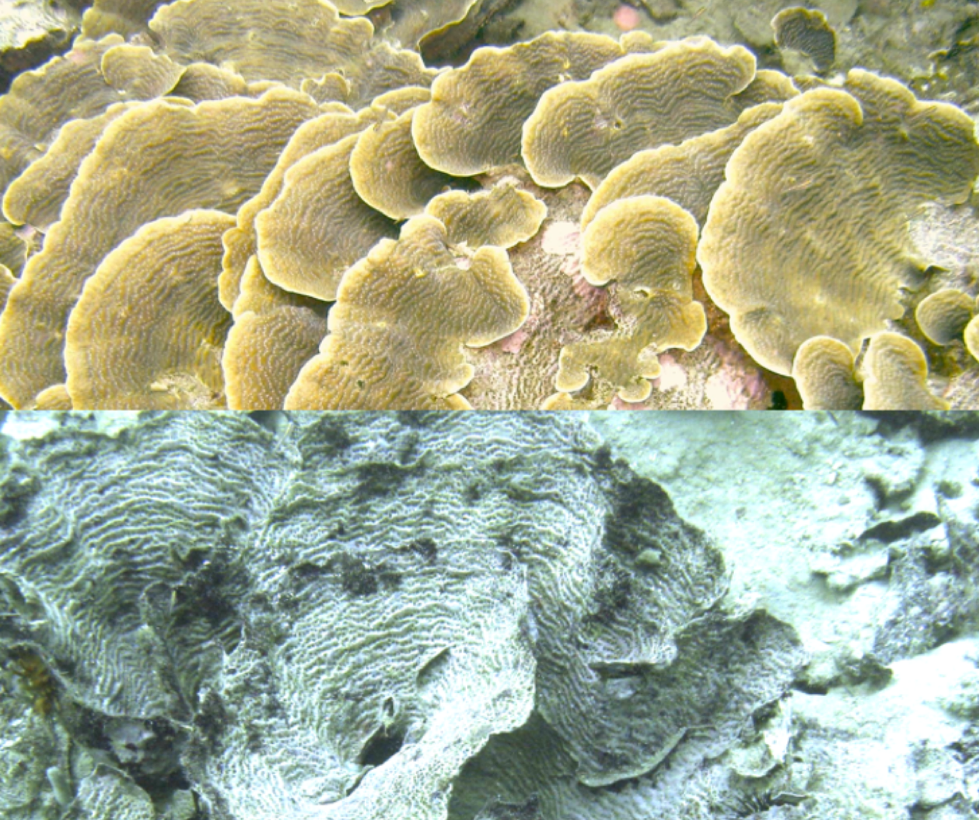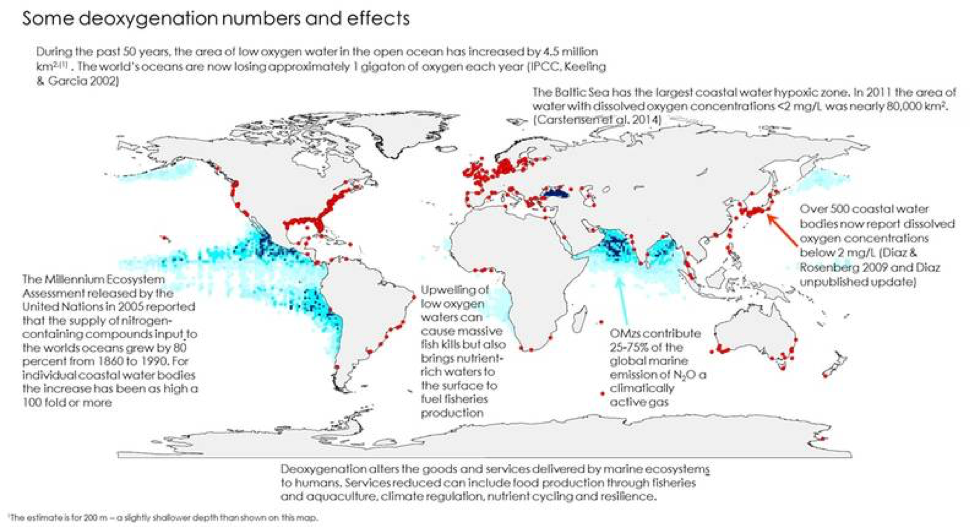Oxygen is critical to the health of the planet. It affects the cycles of carbon, nitrogen and other key elements, and is a fundamental requirement for marine life from the seashore to the greatest depths of the ocean. Nevertheless, deoxygenation, the reduction of oxygen, is worsening in the coastal and open ocean. This is mainly the result of human activities that are increasing global temperatures (CO2-induced warming) and increasing loads of nutrients from agriculture, sewage, and industrial waste, including pollution from power generation from fossil fuels and biomass.

Figure 1. Photographs of the dominant reef-building coral A. lamarcki found alive in normoxic sites (above) versus dead following hypoxia (below). © Andrew Altieri
15 things to know about the declining oxygen in the world’s ocean:
- Oxygen is critical to the health of the ocean. It structures aquatic ecosystems and is a fundamental requirement for marine life from the intertidal zone to the greatest depths of the ocean.
- Oxygen is declining in the ocean. Since the 1960s, the area of low oxygen water in the open ocean has increased by 4.5 million km2, and over 500 low oxygen sites have been identified in estuaries and other coastal water bodies.
- Human activities are a major cause of oxygen decline in both the open ocean and coastal waters. Burning of fossil fuels and discharges from agriculture and human waste, which result in climate change and increased nitrogen and phosphorus inputs, are the primary causes.
- Deoxygenation (a decline in oxygen) occurs when oxygen in water is used up at a faster rate than it is replenished. Both warming and nutrients increase microbial consumption of oxygen. Warming also reduces the supply of oxygen to the open ocean and coastal waters by increasing stratification and decreasing the solubility of oxygen in water.
- Dense aquaculture can contribute to deoxygenation by increasing oxygen used for respiration by both the farmed animals and by microbes that decompose their excess food and faeces.
- Insufficient oxygen reduces growth, increases disease, alters behaviour and increases mortality of marine animals, including finfish and shellfish. The quality and quantity of habitat for economically and ecologically important species is reduced as oxygen declines.
- Finfish and crustacean aquaculture can be particularly susceptible to deoxygenation because animals are constrained in nets or other structures and cannot escape to highly-oxygenated water masses.
- Deoxygenation affects marine biogeochemical cycles; in particular phosphorus availability, hydrogen sulphide production and micronutrients.
- Deoxygenation may also contribute to climate change through its effects on the nitrogen cycle. When oxygen is insufficient for aerobic respiration, microbes conduct denitrification to obtain energy, a process that produces N2O – a powerful greenhouse gas.
- The problem of deoxygenation is predicted to increase in the coming years. Continued greenhouse gas emissions are expected to enhance global warming and in consequence deoxygenation. The global discharge of nitrogen and phosphorus to coastal waters may increase in many regions of the world as human populations and economies grow. It is expected that many areas will experience more severe and prolonged hypoxia than at present.
- Slowing and reversing deoxygenation will require reducing greenhouse gas emissions globally and decreasing nutrient discharges that reach coastal waters. Concerted international efforts can reduce carbon emissions.
- The decline in oxygen in the ocean is not happening in isolation. At the same time, food webs are disturbed due to overfishing and physical destruction of habitats, and waters are getting warmer, more acidic, and experiencing higher nutrient loads. Management of marine resources will be most effective if the cumulative effects of human activities on marine ecosystems are considered.
- More accurate predictions of ocean deoxygenation, as well as improved understanding of its causes, consequences and solutions, require expanding ocean oxygen observation, long-term and multi-stressor experimental studies, numerical modelling and historical and paleo reconstructions.
- Publicly available, accurate oxygen measurements with appropriate temporal resolution and spatial coverage in the marine environment are needed to document the current status of our ocean, to track changing conditions, to build and validate models that can project future oxygen levels, and to develop strategies to slow and reverse deoxygenation.
- Steps required to slow or reverse ocean deoxygenation can directly benefit marine biodiversity and human health and well-being. Sewage treatment and limiting global warming, for example, will improve marine ecosystem health with societal benefits that extend beyond improving oxygen in our ocean and coastal waters.

Figure 2. Some deoxygenation numbers and effects. Source: GO2NE.
Our work on Deoxygenation
The Global Ocean Oxygen Network (GO2NE) – IOC working group is committed to providing a global and multidisciplinary view of deoxygenation, with a focus on understanding its multiple aspects and impacts.
The Network’s research, outreach, and capacity building efforts include facilitating communication with other established ocean science and observation networks and programmes in working groups (e.g. IOCCP, GOOS, GOA-ON, GlobalHAB, WESTPAC O2NE, IMBeR, Future Earth Ocean KAN, SOLAS). The Network’s aim is to improve observation systems, identify and fill knowledge gaps, as well as develop and implement capacity building activities worldwide. GO2NE’s communication efforts include the website ocean-oxygen.org, supported by GO2NE, which provides the latest information on deoxygenation to scientists, stakeholders and the interested public and a monthly webinar, which offers the possibility to listen to two scientists (one junior and one senior) presenting the underlying mechanisms and impacts of ocean deoxygenation.
Global Ocean Oxygen Decade (GOOD): GO2NE and partners are part of the UN Decade of Ocean Science for Sustainable Development. From 2021 to 2030, the Ocean Decade programme GOOD – Global Ocean Oxygen Decade - will raise global awareness about ocean deoxygenation, provide knowledge for understanding causes, attributing changes and developing actions for mitigation and adaptation measures through local, regional and global efforts, including intensified monitoring, transdisciplinary research, bi-directional knowledge transfer among stakeholders and scientists, innovative outreach and ocean education and literacy. The high-level objective of the Decade Programme is to provide data, knowledge, highly qualified personnel via capacity building and best practices to enable society, stakeholders, and scientists to co-design and develop measures that can mitigate the drivers and impacts of ocean deoxygenation and provide appropriate adaptation measures where mitigation is not possible. Developing mitigation of and/or adaptation approaches to deoxygenation are of paramount importance for ensuring the provision of ecosystem services, addressing threats to the climate system and minimizing the impact of ocean deoxygenation on the ocean economy.
Useful links:
Ocean Oxygen News
Oxygen in the International Ocean Carbon Coordination Project (IOCCP)
Past GO2NE webinars
Listen to hypoxia: Impacts of low oxygen made audible, by Project Breathless
Liège Colloquium
Dead zones: how chemical pollution is suffocating the sea (video)
L’océan, l’autre poumon de la planète | Véronique Garçon | TEDxToulouseBusinessSchool (video)
Outreach documents
Kiel Declaration on Ocean Deoxygenation
Ocean deoxygenation: Everyone’s problem (IUCN, 2019)
Ocean Deoxygenation: A Hidden Threat to Biodiversity beyond national jurisdiction (DOSI, 2019)
The Ocean is losing its breath: declining oxygen in the world's ocean and coastal waters; summary for policy makers (IOC, 2018)
Ocean oxygen in the Ocean Observing System Report card 2021
Science Documents
Declining oxygen in the global ocean and coastal waters (Science, 2018)
Multidisciplinary Observing in the World Ocean’s Oxygen Minimum Zone Regions: From Climate to Fish — The VOICE Initiative (Frontiers, 2019)
System controls of coastal and open ocean oxygen depletion (Progress in Oceanography, 2021)
A global ocean oxygen database and atlas for assessing and predicting deoxygenation and ocean health in the open and coastal ocean (submitted to Frontiers, 2021)